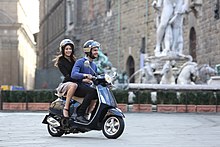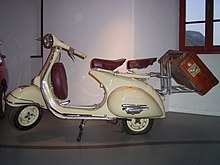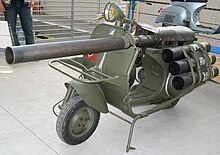Vespa
The Vespa ( Latin / Italian for wasp ) is a motor scooter from the Italian company Piaggio . It is one of the world's best known and most popular types of scooters.
history
The first Vespa, the Vespa 98 , came on the market in 1946 and was nicknamed "Paperino" (duckling); it had a displacement of 98 cc and was capable of a maximum of 60 km / h. Its inventor was Corradino D'Ascanio - an engineer whose dream was to build helicopters . He developed the concept of the Vespa shortly after the end of the war on behalf of Enrico Piaggio , assuming a seated person around whom he arranged the technology of the new two-wheeler. As a former designer of war aircraft , he wanted to go beyond the production of pots and pans with the existing tools.
The original Vespa "98" should be simple, economical and easy to drive - and it should be possible to build it with the existing production facilities. Because Corradino had never designed motorcycles before, he approached this task completely impartially. The drive and the power transmission should be as simple as possible and so he decided on a drive unit swing arm without secondary chain, especially since the chain drive was almost impossible in the time of need due to lack of material. The Vespa should also not have any engine parts that you could get dirty on. Therefore, the engine was completely hidden. The tire change should be as easy as in a car.
At the end of 2016, the Vespa Elettrica study, the first Vespa with an electric motor, was presented at the EICMA in Milan. The E-Vespa is based on the current Vespa Primavera. From spring 2018, the e-Vespa with a range of 100 kilometers and a TFT display with on-board computer was available for purchase from dealers.
Concept and dissemination

For the development of the concept it is important that at the former Piaggio factory airport in Pontedera near Pisa the use of certain resources (factory, material, design experience) should be optimally guaranteed with a small project. The consumers, who mostly still had to suffer from the privations of the war, needed an inexpensive but attractive means of transport that could not be damaged by driving on damaged roads. As so often in the history of technology , these limitations resulted in an ingeniously simple concept, the Vespa . Her name was registered for a patent on April 23, 1946. With just 3.2 hp, it reached a speed of 60 km / h. The very simple structure of the chassis with short swing arm at the front and drive unit swing arm at the rear has been retained to this day. This results in the design-related disadvantage of limited suspension comfort and weaknesses in driving behavior. However, this did not detract from the success of the Vespa.
The next type "Vespa 125" (1953) had 5 HP and was 75 km / h fast. Among other improvements, the headlight was now mounted above the handlebars. Further innovations followed in 1955 with a 150 cm³ engine, four-speed gearbox, long double saddle and a top speed of 100 km / h.
In 1965 more than three million Vespas had already been sold worldwide, after which their triumphant advance in Europe slowly ebbed, because the automobile became affordable for the broad masses . However, the Vespa became one of the most important means of transport in India and parts of Asia as well as some countries in Africa, and in some cases it still is today. In addition to Germany, various Vespa models were built under license in all parts of the world. B. in India by Bajaj and LML , in France by ACMA , in England by Douglas , in Pakistan, in Iran and in Malaysia. In the USSR, the GS3 was copied and built under the name Vyatka without a license in a slightly modified form in large numbers.
For older and rare models such as the Vespa U , Hoffmann Vespa , Vespa SS50 and SS90 or the French military Vespa TAP 56 or 59 , from the license production of the company ACMA, are collector's prices paid.
The manual Vespas are criticized for the fact that the technical equipment does not correspond to the current state of the art ( ergonomics , environmental compatibility , etc.), on the other hand they have several advantages based on this: the design independent of fashion or the possibility of self- repair .
The supply of spare parts for vehicles from Piaggio is good, and the market also offers a wide range of additional items.
Vespa in Germany
In the 1950s, the Vespa also became known north of the Alps and became a favorite vehicle, especially among the younger generation. The first Vespas were exported to Switzerland as early as 1947, and they came to Germany around 1950. Jakob Oswald Hoffmann signed a license agreement with Piaggio in 1949 and began building Vespas for the German market in Lintorf in the Rhineland from spring 1950. Between 1950 and 1953 he built the HA model and only in 1953 the HB model.
At great financial expense and due to the great competition, especially from the more powerful “Lambretta” scooters from the manufacturer Innocenti, Hoffmann continued to develop the Vespa (especially its engine) without the approval of the Piaggio works and finally brought the “Queen” onto the market in 1954. Piaggio then terminated Hoffmann's license agreement without notice.
In addition, Hoffmann put a lot of effort into developing a scooter mobile (Hoffmann cabin) similar to the BMW Isetta . Due to the very great similarity and the patent rights that were infringed, the BMW Group sued the Hoffmann-Werke. BMW won the process. Therefore, and because of the investments in the abandoned Vespa production, the Hoffmann-Werke had to file for bankruptcy at the end of 1954. Vespa production was continued in the Messerschmitt works in Augsburg.
For a certain period of time there were two manufacturers and suppliers of Vespas in Germany during the insolvency phase of the Hoffmann-Werke and at the same time when the Messerschmidtwerke started production, as Hoffmann's insolvency estate also contained a number of pre-produced sets of parts from which the insolvency administration instructed Complete scooters were assembled and sold.
Past and current types
Only a selection of the earlier types is given:
- 1946, Vespa 98 : 3.2 HP (98 cm³), around 60 km / h
- 1948, Vespa 125 : 4.5 HP (125 cm³), 70 km / h
- 1954, Vespa 150 : first Vespa with 150 cm³
- 1955, Vespa 150 GS : 150 (145.5) cm³ engine, four-speed gearbox, 10 "wheels, 85 km / h
- 1957, Vespa 125 : 125 cc engine, 8 "wheels, approx. 75 km / h, 4.5 hp at 5000 rpm, 1:20 mixture (VNA1T: 1957-58; VNA2T: 1958-59)
- 1957, Vespa 400 : 4-wheel microcar with 393 cm³
- 1959, Vespa 125 VNB: This model was produced with 3 or 4 gears and had different key figures from 1–6 after the abbreviation VNB (e.g. VNB4T)
- 1959, Vespa 150 : 150 (145.5) cm³ engine, 3 gears, 8 "wheels, approx. 85 km / h, VBA1T 1959–1960 (Tecnica)
- 1960, Vespa 150 VBB: 150 (145.5) cm³ engine, 4 gears, 8 "wheels, approx. 85 km / h
- 1962, Vespa 160 GS : 160 cm³ engine, four-speed gearbox, 10 "wheels (from Vespa Tecnica)
- 1962, Vespa 150 GL: 150 (145.5) cm³ engine, 4 gears, 10 "wheels, approx. 90 km / h, VLA1T 1962–1965 (Tecnica)
- 1964, Vespa 50 : The first "small Vespa" (in smallframe construction) with the 50 cm³ unit and 3 gears for the " moped class"
- 1965, Vespa 125 Nuova : first Vespa with 125 cm³ in a small frame (wider leg shield and short wheelbase)
- 1965, Vespa 180 SS: 180 cm³ engine, cylinder suction, 4 gears, approx. 90 km / h
- 1965, Vespa 150 Sprint : 150 cm³, 4 gears, 10 "wheels, approx. 90 km / h, VLB1T 1965–1979 (Tecnica)
- 1965, Vespa 125 Super: 125 cm³, 4 gears, last Vespa with 8 "wheels, frame number: VNC1T 1001 to VNC1T 025146.
- 1965, Vespa 125 GT : 125 cm³, 4 gears, larger frame, 10 "wheels,
- 1968, Vespa 125 Primavera : One of the most popular Vespas with a more powerful engine
- 1968, Vespa 180 Rally : with 10.3 hp, top speed of 104.8 km / h
- 1970, Vespa 50 Elestart: for the first time with electric starter, 3- and 4-speed, 40 km / h
- 1972, Vespa 200 Rally : with 12 hp, top speed of 105 km / h
- 1977, Vespa P 125 X: New body and more modern technology, Vespa P 200 E with electronic 12 V ignition system
- 1978, Vespa P 150 X:
- 1981 (only for Germany): P 80 X available with 80 cm³.
- 1983, Vespa PK (50 and 125 cm³; for Germany also with 80 cm³): The successor model of the Primavera gets a more modern, smooth body in line with the zeitgeist of the 80s. The 50s have 3- or 4-speed gearboxes; the 125s and 80s basically have 4 gears; Electric starter available for an extra charge.
- 1984, Vespa PK Automatica with 50 and 125 cm³ (for Germany also with 80 cm³): first automatic Vespa ever.
- 1985, Vespa T5 Pole Position : limited special model with 12 HP, the most powerful of all 125 series Vespa scooters, aluminum cylinder with 5 transfer ports, SI24 / 24G carburetor with a shorter intake path and a special air filter.
- 1985, Vespa PX Lusso with 80, 125, 150 and 200 cm³. Improved version of the PX with separate lubrication, stronger front axle and improved locking system. The battery is completely eliminated in models without an electric starter, which contributes to the ease of maintenance and reliability of the lighting system. The ignition lock moves from the speedometer cover into the steering wheel lock, which improves theft protection. The speedometer is now larger, the indicator lights for turn signals and high beam move with the speedometer area. There is an electronic tank level indicator. The reserve function of the fuel tap is omitted. 200 cm³ version with 10 HP (standard) and 12 HP (GS). There is an optional electric starter for all engine variants. These versions have a battery.
- 1989, Vespa Cosa with 125, 150 and 200 cm³ with technical innovations such as hydraulic combination brake, e-choke and e-fuel tap (the latter with anti-lock braking system on request ).
- 1996, Vespa ET : is a success with 460,000 units produced and is available with an injection engine for the first time
- 2002, Vespa GT with 125 and 200 cm³ 4-valve four-stroke engines, variator and, for the first time, water cooling
- 2005, LX 50 (two- or four-stroke engine), LX 125/150 ie 3V (air-cooled 3-valve four-stroke engine, injection, variator)
- 2005, Vespa GTS 250 ie / GTS 250 ie ABS (four-stroke engine with injection, variator)
- 2006, Vespa GTV 125/250 later 300 - like GTS - but with headlights on the front fender ("60 years edition")
- 2007, Vespa GTS 125 complied with the Euro 3 emissions standard.
Models currently on sale

- S 50 (two- or four-stroke engine), S 125/150 ie 3V (air-cooled 3-valve four-stroke engine, injection, variator)
- Vespa GTS 125 ie Super (water-cooled 4-valve-4-stroke engine, injection, variator).
- Vespa GTS 300 ie Super (water-cooled 4-V-4-stroke engine, injection, variator).
- Vespa PX 125/150 (new edition of the old PX , air-cooled 1-cylinder, 2-stroke engine, 4-speed gearbox, manual).
- Vespa 946 (air-cooled 125 cm³ and 150 cm³ four-stroke engine with 3 valves, variator, ABS and ASR)
- Vespa Primavera (air-cooled 50 cm³ two-stroke engine, 50 cm³, 125 cm³ and 150 cm³ four-stroke engine, variator)
- Vespa Sprint (air-cooled 50 cm³ two-stroke engine, 50 cm³, 125 cm³ and 150 cm³ four-stroke engine, variator)
- Vespa Elettrica (electric motor with 4 kW and 200 Nm, 45 km / h top speed, 100 km range (200 km with Range Extender (Version X)), multimedia on-board system - from October 2018)
Overview
| model | Cubic capacity cm³ | construction time |
|---|---|---|
| Vespa 50 | 49 | 1963 to 1991 |
| Vespa 98 | 98 | 1946 to 1947 |
| Vespa 125 | 125 | 1948 to 1969 |
| Vespa 125 GT | 125 | 1966 to 1973 |
| Vespa 125 Primavera | 125 | 1967 to 1982 |
| Vespa 946 | 124 | 2013 to 2016 |
| Vespa Primavera | 49 to 155 | 2013 to date |
| Vespa PK | 49 to 121 | 1982 to 1996 |
| Vespa Cosa | 123 to 198 | 1987 to 1998 |
| Vespa PX 125 | 122 | 1985 to 1990 |
| Vespa ET | 49 to 151 | 1996 to 2005 |
| Vespa GTS | 124 to 278 | 2003 to date |
| Vespa LX | 49 to 155 | 2005 to 2013 |
| Vespa 150 | 145 | 1954 to 1979 |
| Vespa 160 GS | 145 | 1962 to 1965 |
| Vespa 150 Sprint | 145 | 1965 to 1979 |
| Vespa 180 rally | 180 | 1968 to 1973 |
| Vespa 200 rally | 198 | 1972 to 1979 |
| Vespa P 200 E | 198 | 1977 to 1982 |
| Vespa PX | 79 to 198 | 1977 to 2016 |
| Vespa 400 | 394 | 1957 to 1961 |
The motorized “ wasp ” (Vespa) also has a relative, the “bee” ( ape ), which is still a popular tricycle transporter in the region around the Mediterranean Sea.
Driver and Social
The scooters that are still in production today have achieved cult status . Some Vespa drivers refer to themselves as “Vespisti”, some of which are organized in clubs, car pools and regulars, with regular meetings (Vespa World Days, National Vespa Days etc.) or rallies taking place.
The first Vespa clubs were founded in the late 1940s. The local local clubs were brought together by umbrella organizations in individual countries (e.g. Vespa Club Austria, Vespa Club of Germany , Vespa Club Switzerland etc.). In Europe, the Vespa Club d'Europe was created, which then became the FIV (Federation Internationale des Vespa Clubs). The FIV, in turn, dissolved at the end of 2005 and was replaced in 2006 by the "Vespa World Club".
The Vespa “scene” is mainly divided into Vespa “screwdrivers”, classic car enthusiasts, touring drivers and “everyday users”. In Germany, some of the Vespisti were called "Prodomo drivers" - that was originally an insult for those Vespa drivers who were not ready to devote themselves body and soul to their vehicle, that is, in a figurative sense, were ready to take their place Satisfying real espresso with a brewed coffee like Dallmayr Prodomo. Meanwhile there are also self-confessed "Prodomists" and "Prodominas".
In Germany, in addition to the club newspaper of the VCvD (the "Vespina"), the WESPE has been on the market since July 1, 2014 . The Waspe is a quarterly print magazine that deals exclusively with the Vespa topic. Topics include restorations, trips, background reports, product presentations and much more. The WESPE has also been sold in Austrian newsagents since the end of 2014.
Vespa in art

Artists have been modifying their scooters into custom scooters since the 1960s . The German artist Eberhard Bosslet realized four photo series on the Canary Islands , Spain, under the title “Mobilien & Immobilien” . An old Spanish Motovespa Sprint "04C" from 1966 was used, which he often painted in alternating dialogue with the backgrounds.
literature
- Branislav Dimitrijević: Socialist Consumerism, Westernization and Cultural Reproduction. The "post-communist" transition in Tito's Yugoslavia. In: Back from the future. Eastern European Cultures in the Age of Post-Communism. Edited by Boris Groys et al. Suhrkamp, Frankfurt am Main 2006, pp. 195–277, p. 217. ISBN 3-518-12452-8 (In the section “Love, fashion, competition” interesting explanations on the historical conditions of the emergence of the Vespa concept and on the role Italian scooter in (film) culture).
- Giorgio Sarti, Luciano Greggio; Antonio Corona (photos): Vespa - The official chronicle: 1946 to today (translated by Dorko M. Rybiczka and Walther Wuttke). Heel, Königswinter 2011, ISBN 978-3-86852-384-3 .
- Guido Schwarz: Vespa - what a life! Stories of Passion, Love and Soldering Iron , Guido Schwarz, Vienna 2011, ISBN 978-3-200-02267-6 ; New edition 2013: Vespa stories from Vienna to Rome, ISBN 978-3-200-02874-6 (the Vespa phenomenon as an attitude towards life in the post-war period).
- Valerio Boni, Azzurra Della Penna: Vespa: cult on two wheels . Prestel, Munich 2014, ISBN 978-3-7913-4890-2 .
Comparable vehicles
Web links
Individual evidence
- ↑ Wolfgang Kaes : Freedom on two tiny wheels , General-Anzeiger, Bonn, April 16, 2016
- ↑ "Now the Vespa comes with an electric motor", article at: stern.de
- ↑ "The electric Vespa is coming: manufacturer promises" artwork with a heart "", article at: chip.de
- ↑ Fig
- ↑ Vespa Elettrica 2018 - E-Vespa with a range of 200 km www.motorradonline.de
- ^ Spiegel Online: Jürgen Pander: The mother of all motor scooters. A feeling called Vespa
- ↑ The Wasp








